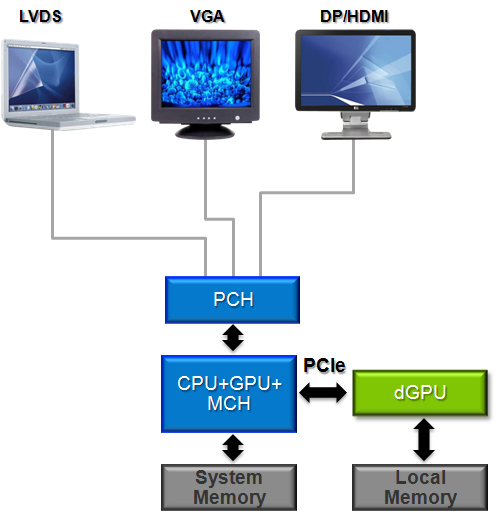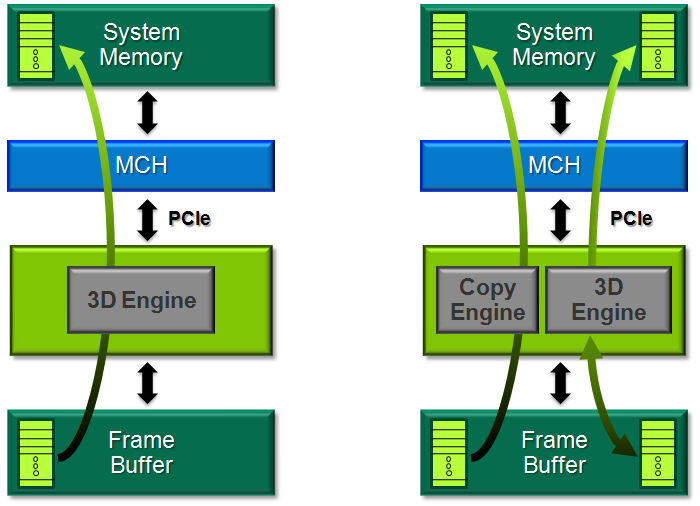Nvidia Primes Optimus Mobile Graphics Tech
An alternative to the switchable graphics technology found on some Intel-based notebooks, Nvidia's Optimus technology promises smoother switching for trouble-free operation.
Last week, Nvidia briefed Tom's Hardware on its newest mobile technology, dubbed Optimus. While we previously posted rumors concerning the Optimus announcement, we can now reveal that Nvidia hopes to optimize battery life and performance on mobile computers simultaneously through this feature using a form of automatic switchable graphics.
Optimus is a hardware- and software-based technology that determines when applications require discrete graphics via software, supplying power to the GPU in response. This is done automatically (more detail on the automatic functionality below), without the need to manually switch between integrated and discrete graphics, which we agree is a cumbersome process for notebook users and is a characteristic of the switchable graphics technology supported through the latest Intel Calpella platform.
The benefits of Optimus, Nvidia claims, are potentially welcome changes. Supported on all Arrandale (Core i3, i5, and i7), Penryn (mobile Core 2 Duo) and Pine Trail (Atom N4xx) processors, Optimus attempts to balance performance and battery life. The technology is built to take advantage of the discrete graphics processor only when it’s required, so you only sacrifice runtime for performance when a demanding workload is applied.
Unlike some of Nvidia’s other projects, Optimus will require significant development and cooperation from its OEM partners before it can be implemented. Asus, the first vendor to employ Optimus, will launch its UL50Vf notebook this week. The company has also announced four other models. According to Nvidia, competing vendors are expected to make similar announcements in the coming months. Unfortunately, it'll likely be difficult to gauge the benefits of Optimus on the UL50Vf, as the system includes a 1.3 GHz Core 2 Duo SU7300 processor and GeForce G210M GPU--not quite what we'd consider a platform in need of much more 3D muscle than integrated graphics would otherwise deliver.
Nevertheless, it's important to note that current notebook designs and GPUs will not work with Nvidia’s Optimus technology. Only newer models featuring Optimus-enabled GPUs with a built-in Copy Engine (explained below) will work, including the following: the GeForce 200M-series, 300M-series, upcoming GeForce M and ION GPUs.
Optimus’ function can be boiled down as such: minimize the hassle of switching from integrated to discrete graphics and vice versa. You’ll still give up performance in integrated mode and battery life when the system is utilizing the discrete GPU. But by making this switch demand-based, the transition should be less jarring.
How It Works
Get Tom's Hardware's best news and in-depth reviews, straight to your inbox.
Today’s Intel-based switchable graphics deployments include an actual switch, which changes the display from the IGP to the GPU. This process requires powering on the GPU, switching between the driver interposer and multiplexers, and can take between 5-10 seconds. Once the GPU is active, (provided the implementation is correct; each OEM has different methods to switch between integrated and discrete graphics), the laptop is able to serve up additional performance. Of course, this is also contingent on the user remembering to manually switch, deal with screen flickering, and closing what are called “blocking apps,” which do not allow the switch. Should the user be unwilling to compromise here and not switch back and forth, there go the benefits of switchable graphics. Thus, Nvidia says Optimus will benefit those who were previously not using Switchable Graphics as intended.
Optimus employs several notable changes to both the hardware and software designs currently in use. The Routing Layer powers the GPU based on DirectX , DXVA calls (DirectX Video Acceleration), CUDA calls, and a predetermined list of profiles. The Optimus profiles are comprised of a list of applications that Nvidia validates and automatically updates on all machines with the technology enabled. These small text files specify whether or not the application in question should employ the discrete GPU or leave integrated graphics enabled.
If the GPU is needed, the routing layer spins up the discrete GPU via fast initialization. This means that, when the GPU isn’t being utilized, it isn’t powered on, as with switchable graphics. Applications can also be manually set to use discrete or integrated graphics, among other customizable features. Nvidia’s control panel will include independent discrete and integrated settings for laptops with Optimus. Optimus only works on Windows 7, because it requires multiple display drivers to operate.
Once the GPU is utilized, the IGP automatically serves as a display output for the GPU over PCIe. This is possible because the GPU is now directly connected to the IGP, requires no multiplexing, and includes the requisite Copy Engine built into compatible GPUs.
All in all, Optimus facilitates simpler hardware designs, since it's connected to the IGP via PCI Express. It's primarily software-driven, making it easy to optimize, too. What remains to be seen is how many vendors actually adopt the technology.
-
r3t4rd back_by_demandIs it just me or did you think "Transformers" when you read the title?!?LOL...yes I did. Funny the Article's Headline uses "Prime" and "Optimus".Reply
And thinking about Transformers....I remember, to this day, watching Transformers: The Movie back in the 80's at the theatre, and when Prime died...*sniff sniff*...I cried - really. Almost brings that nostalgic surreal feeling backing thinking of it. -
@r3t4rdReply
I think the title was intended to make a play on the name of the product ("Optimus") in order to make a Transformers reference... -
back_by_demand pickleme@r3t4rdI think the title was intended to make a play on the name of the product ("Optimus") in order to make a Transformers reference...Really? You think?Reply -
r3t4rd pickleme@r3t4rdI think the title was intended to make a play on the name of the product ("Optimus") in order to make a Transformers reference...I couldn't have figured that out...thanks for the help.Reply -
Honis Is James Pikover a new Toms writer? This article was clear, informative and not slathered with opinion.Reply
If this really will increase my battery life and provide me a gaming notebook and a normal notebook in one I'm all for it.



